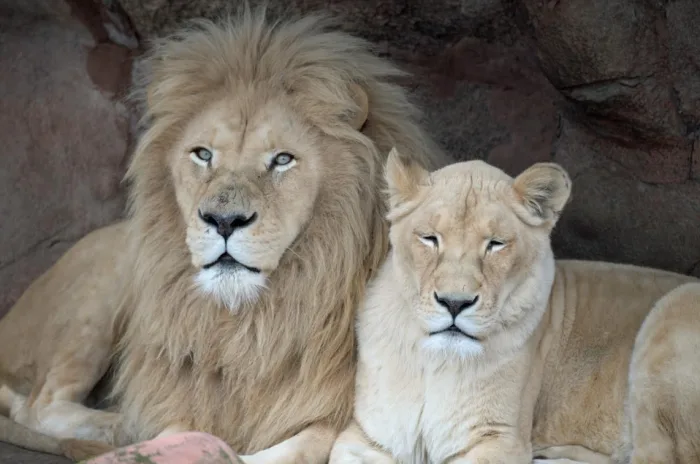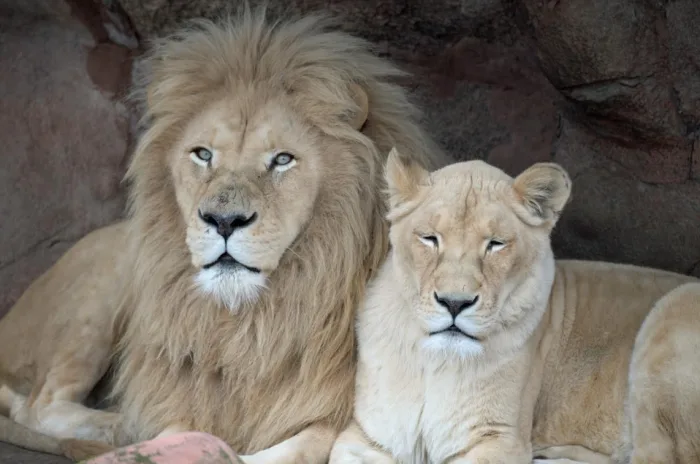
How tropical animals at the Toronto Zoo stay warm in the winter
The Toronto Zoo roars with activity year-round ... even during the coldest months.
Contrary to popular belief, the Toronto Zoo doesn’t close down as soon as the snow flies. In fact, fall and winter are some of the best times to visit the vast, world-class zoo that resides in the city’s east end.
I headed out to the zoo in mid-January to see how the zoo deals with the mix of cold weather and tropical animals. My first stop was the white lion exhibit with Keeper Amanda Taylor in the African Savanna section. As I walked up to the exhibit, the snow crunched under my feet, but the quiet swirl of the wind is what struck me the most. I’m used to being at the zoo when the crowds are almost overwhelming, the sound of hundreds of people all crowding close to get a glimpse of the lions.
Now, three lions lounged in the cozy cave facing the observation area, lazily watching the world drift by. They did perk up when they realized that Amanda had brought meatball treats for them. As Amanda lobbed them over the wall and into the waiting jaws of the delighted cats, I asked her about how the lions took to the cold weather.
“Lucky for us these guys came to us as cubs, so they’re a bit more acclimatized to the winter than some of the other cats that have come to us,” she told me. “We also have heated caves for them which allow them to roam the exhibit and still have a place to come to for warmth.”
“We do see a little bit more fur on them and we do feed them a bit more in the winter so that winter weight really does help them to keep warmer in the cooler months,” she added.
The zoo has temperature guidelines: -10°C means keep them in, but even then they’re getting training in the rear enclosure. Ice is a big problem for the lions because they could slip. And lions don’t go sledding -- at least according to Amanda.

Lions at the zoo. Courtesy: Mark Robinson.
A journey from the tropics to the Arctic normally takes days, involves multiple airlines, and the likelihood of lost luggage. At the zoo, it’s about a 10-minute walk. Polar bears are an iconic Arctic species and at the zoo, and they enjoy the winter months far more than the lions do.
“This is the best time of the year to see the polar bears, they’re super active,” said Andy Cockburn, one of the keepers in the Tundra Domain section. “They love big snowfalls; we’ll bury their food in snow piles or freeze in blocks of ice.”
I watched as the two bears roused themselves out of a sleep, as the keepers walked up to their observation platform with food. A crowd gathered as the keepers began a show designed to educate them about the realities of polar bear life.
Though I was seeing them in their preferred element, they are also pretty well adapted for warmer weather.
“During the summer months they shed their thicker coats,” Andy told me.
“We feed them seasonally. In the summer we cut back on their food and being thinner, they stay nice and cool. They also love being in the water and they really enjoy showers.”
Polar bear showers are not something I expected to enter my lexicon, but before I had time to process that it was off to the Africa Pavilion for an indoor respite from the cold.
Also, lemurs.
Ringtail lemurs are native to Madagascar but are also well known in many zoos, including Toronto. They’re cute, cuddly, and they like to “stink fight.”
VIDEO: LEMURS AT THE TORONTO ZOO
The males have scent glands on their wrists and shoulder. During a stink fight, they drag their tails past the glands and then flick the tails at each other. They waft their scents toward each other until eventually one male backs down. It’s basically a way to impress girls. (I prefer using a nice suit, but I’m not a ring-tailed lemur.)
While the lemurs seem pretty resilient when it comes to intense smells, they’re not as keen about the cold of a Canadian winter. That’s why they spend the winter months inside the Africa Pavillion, a massive structure where the temperature was almost summer-like and I had to shed my outer jacket. To my delight, Heidi Manicki, a keeper at the Africa Pavilion, pulled out a set of keys and invited me into the exhibit to see the lemurs up close. As we entered, the lemurs ran over to us to see what treats we had for them. One of the other keepers pulled out a bucket filled with a wide variety of fruits.
I asked Heidi how the lemurs deal with Canadian winters and it turns out that it’s through a combination of hugs and a furnace.
“The Africa Pavilion never gets too cold because we have a heating system that maintains a tropical temperature year-round,” Heidi told me while lemurs scampered around our feet, oblivious to the snow falling outside.
They moved with a quick grace up an over the various obstacles in the exhibit as Heidi pointed out a knot of them sitting on a ledge.
“If it does get too cold, they huddle together for warmth so tightly that it’s hard to tell where one begins and the other ends.”
They also have another trick for getting warm on sunny days: yoga. Well, sort of. Heidi explained, “If it’s a sunny day, they’ll sit in a pose similar to what you see in yoga. Where humans tuck their legs under when they sit and have their arms out (think meditation pose), lemurs will sit with legs out and palms up, gathering in the warmth from the sun.”
Animals that don’t have the luxury of yoga poses may use heat lamps or concrete warming pads to keep warm on the coldest days. Others have heated pools or well-maintained aquariums.
For us two-legged mammals, we still have to rely on jackets and snow pants, boots, and gloves to keep warm in the winter. So, don’t forget to bring all of that gear when you come to visit the zoo in the winter and remember, lions don’t go sledding.
But the gorillas might (which is a story for another time. Stay tuned!)
Editor's note: This story was produced and published in February 2020, prior to the COVID-19 pandemic shutdowns and mask mandates.










